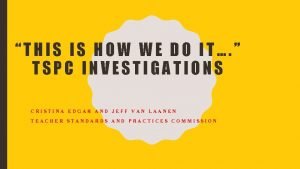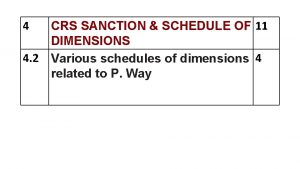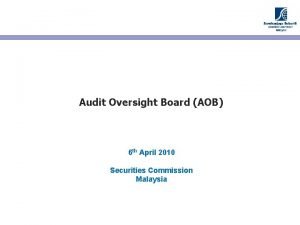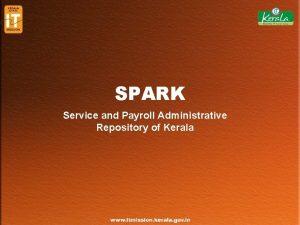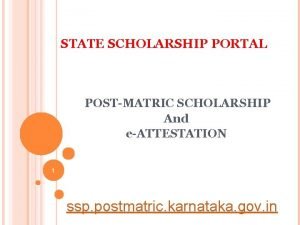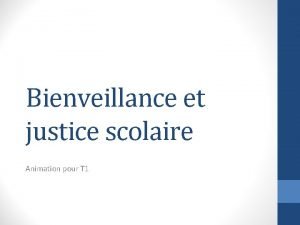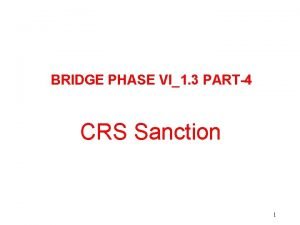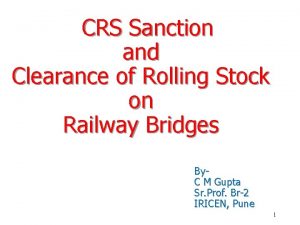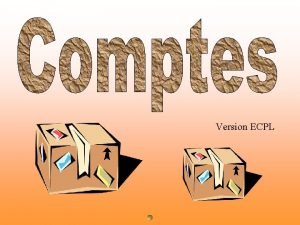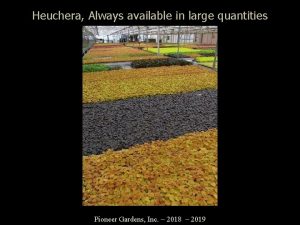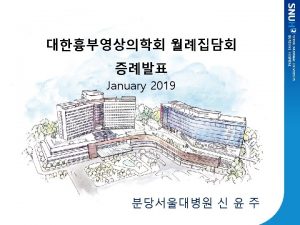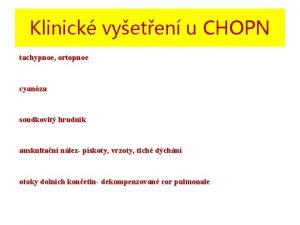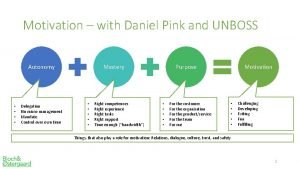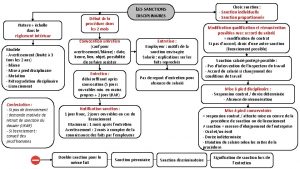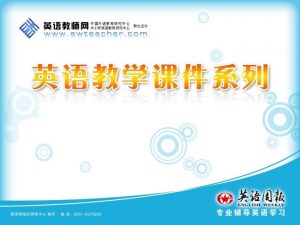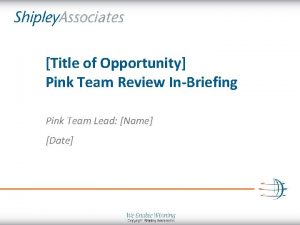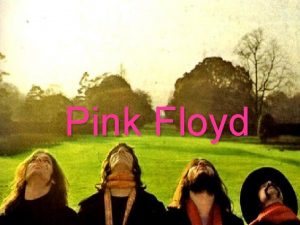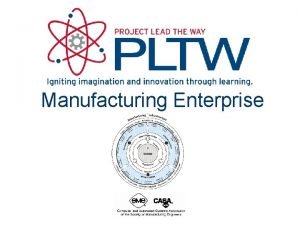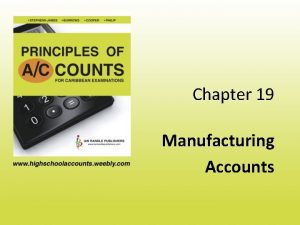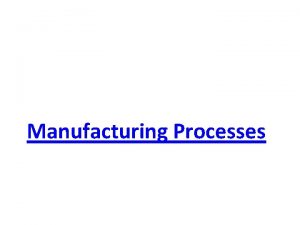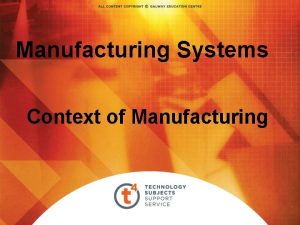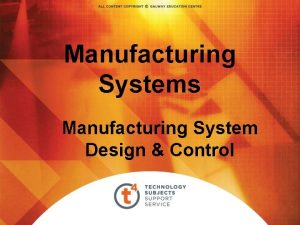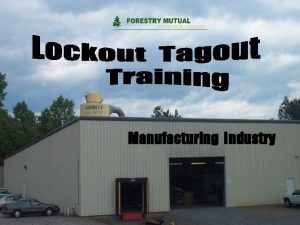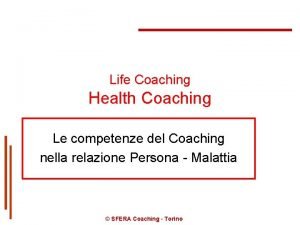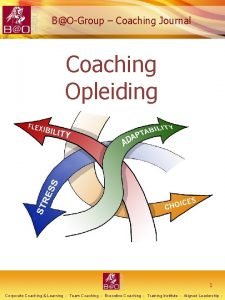Coaching stock Manufacturing of coaching stock Sanction Pink























- Slides: 23

Coaching stock

Manufacturing of coaching stock • Sanction (Pink book, RSP) (Nodal directorate-PU) • Issue of Particular specification including Electrical part and layout plan by RDSO – General layout – Type of shell and Bogie – Type of key materials and systems (brakes, electrics etc) • Preparation of detailed drawings by Mechanical design of PU

Manufacturing of coaching stock • Preparation of detailed drawings by Electrical design of PU • Issue of material schedule for procurement of materials • Setting up jigs and fixtures • Manufacturing of prototype • Tests and trials in coordination with RDSO • Issue of speed certificate by RDSO • CRS sanction

Head On Generation (HOG) Coaches

SELF GENERATION (SG) SYSTEM • Generation is AC which after AC-DC rectification becomes 110 Volt DC (with battery back up) for lights & fans. For AC (RMPU) , it gets converted into 415 V, 3 ph through Inverters. END-ON-GENERATION (EOG) SYSTEM • 750 Volt Generation from DG sets placed in power cars at the ends. HEAD-ON-GENERATION (HOG) SYSTEM • Power Supply from OHE through LOCO Transformer

SELF GENERATION SYSTEMS Ø Axle driven under slung alternator with V - belts Ø 110 V DC regulated at different speeds through RRU Ø Battery back up during standing/slow movement of train Ø 2 X 25 KVA, 110 V DC/415 V inverters for AC load. Ø 110 V DC supply for lights and fans

MOUNTING ARRANGEMENT OF AXLE DRIVEN ALTERNATOR

SGAC LAYOUT Belt Pulle y Pulley mounted on Wheel 3 Phase AC Alternator Rectifier cum Regulator Unit Self Generation System Battery 25 k. VA AC Coach Inverter AC Control Panel AC Package Unit Light & fans

Batteries for TL & AC v Non-AC Coaches 120 Ah- 110 V DC (nominal) , 18 Mono blocks of 6 volt each v Air Conditioned coaches 1100/800 Ah (VRLA/low maintenance)- 110 V DC: 56 cells of 2 Volt each. Alternator for TL & AC • Non AC- 4. 5 k. W • AC (RMPU)- 25 k. W, AC (US)- 18 k. W

ADVANTAGES OF SG SYSTEM Ø Flexibility in rake formation Ø Independent of mode of traction Ø No separate power car required Ø Failure in one coach do not affect other coach Ø Feed extension is possible in emergency from adjacent coach

DISADVANTAGES OF SG SYSTEM Ø Load restricted to 2 X 25 kw per coach Ø Bulky 1100 Ah(AC)/ 120 Ah (Non-AC) coach battery required during standby / slow movement Ø No standby alternator/battery Ø Extensive maintenance due to under-slung alternator, battery, axle-pulley Ø Poor system efficiency 54%

END-ON-GENERATION SYSTEM ØRajdhani, Shatabdi type fully AC trains with large power requirements. ØTwo power cars each with 2 X 250 k. W (new high Capacity ) Diesel alternator sets. ØPower fed by two feeders 750 V 3 - ph by I V couplers step down to 415 V 3 ph for AC by 50/60 k. VA transformers Ø 110 V AC lighting and fans by 415/110 AC transformer


Advantages of EOG system Ø No restriction of Load due to high capacity power cars Ø Does not require bulky batteries, alternators Ø Standby DA sets Ø Independent of mode of traction Ø Less maintenance required due to elimination of under slung alternator, battery, axle pulley etc. Ø Higher system efficiency

Disadvantages of EOG system Ø Flexibility in rake formation not possible Ø High cost of energy due to high fuel cost Ø Noise and smoke pollution from power car Ø Passenger capacity reduced due to provision of power car

HEAD-ON GENERATION SYSTEM (HOG) Ø Power supply received from loco or tapped from OHE in power car Ø Cost effective, reliable and energy efficient Ø Elimination of heavy under slung alternator in SG coaches and DA sets in EOG power car avoiding noise and smoke pollution

HOG SYSTEM Ø Single phase power from OHE through Loco/ separate Pantograph in power car. Ø Inverter (single phase to 3 phase) can be bulk mounted on/under power car or individual coach.



TL & AC Maintenance

Maintenance schedules Ø Trip maintenance, under gear and safety checking Ø Monthly maintenance : Schedule ‘A’ Ø Quarterly maintenance : Schedule ‘B’ Ø IOH after 9(conventional)/18 Months (LHB) : Schedule ‘C’ Ø Periodical Overhauling (POH) : once in 18 (conventional)/36 Months (LHB)

Maintenance philosophy Ø At present all TL items like alternators, regulators, fans, lights, battery are maintained departmentally. Ø Under- slung type AC Coaches all equipment like compressors, condenser, evaporator, panel are maintained departmentally. Ø Contract with OEM for 4 -monthly schedule of inverters. Ø Comprehensive service contract for RMPU for Trip, monthly, 3 monthly & Periodic overhaul with RDSO approved sources. Ø Selective outsourcing of ACCA.

THANKS
 Manufacturing cost vs non manufacturing cost
Manufacturing cost vs non manufacturing cost Manufacturing cost vs non manufacturing cost
Manufacturing cost vs non manufacturing cost Additively
Additively Job order costing vs process costing
Job order costing vs process costing Non controllable cost
Non controllable cost Tspc educator sanction list
Tspc educator sanction list Trolley refuge dimension
Trolley refuge dimension Audit oversight board
Audit oversight board Sparkservice and payroll
Sparkservice and payroll Https://ssp.postmatric.karnataka.gov.in/cis/
Https://ssp.postmatric.karnataka.gov.in/cis/ Différence entre punition et sanction animation
Différence entre punition et sanction animation Vi1 certificate
Vi1 certificate Relevance of directive principles of state policy
Relevance of directive principles of state policy Crs sanction
Crs sanction Kriteria stock yang baik
Kriteria stock yang baik Long-term debt preferred stock and common stock
Long-term debt preferred stock and common stock Characteristics of corporate bonds and stocks
Characteristics of corporate bonds and stocks Stock initial
Stock initial Coral bells magma
Coral bells magma Pink tinged sputum
Pink tinged sputum Peakflowmetr
Peakflowmetr Pinkwashing
Pinkwashing Pink theory of motivation
Pink theory of motivation Pink
Pink





